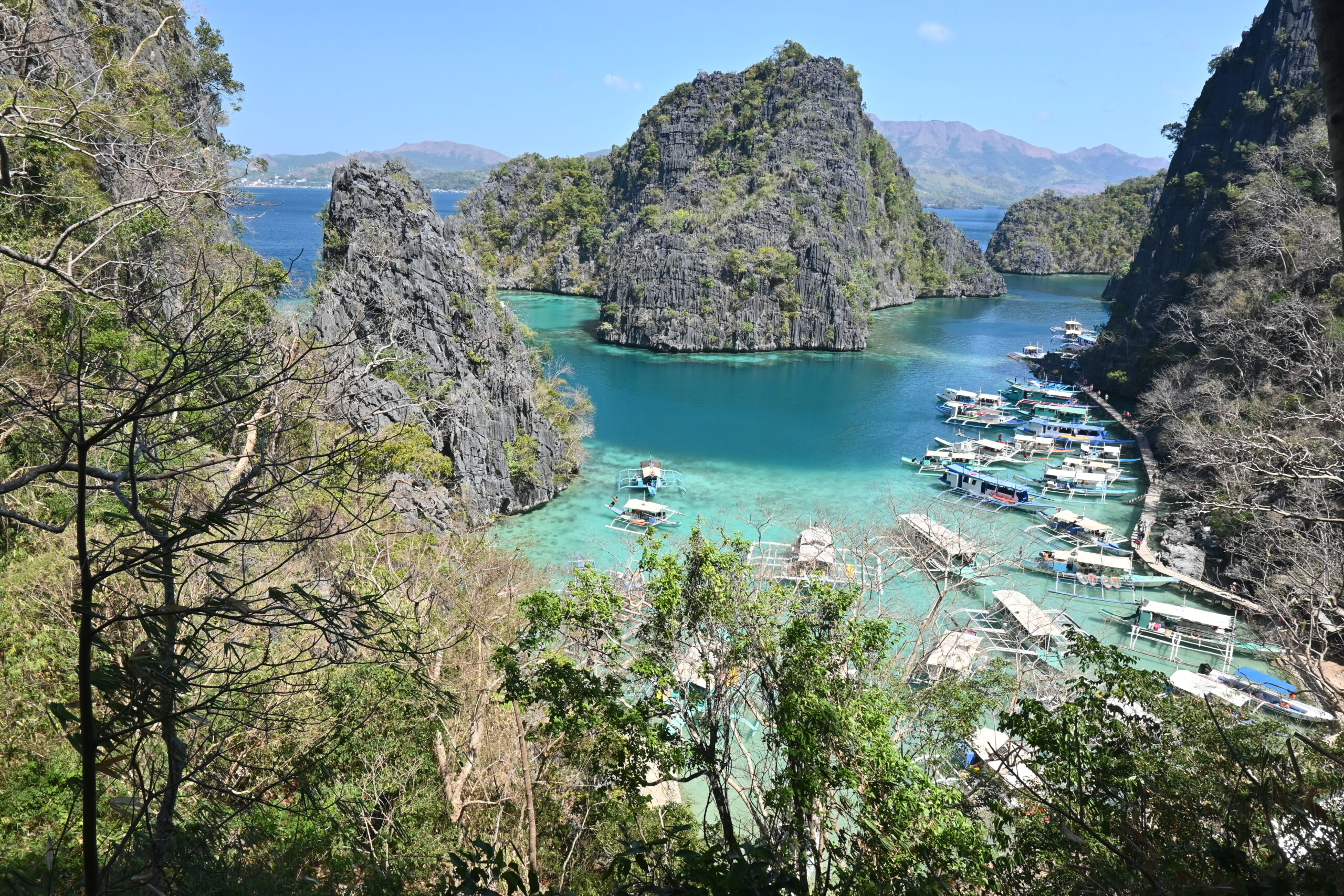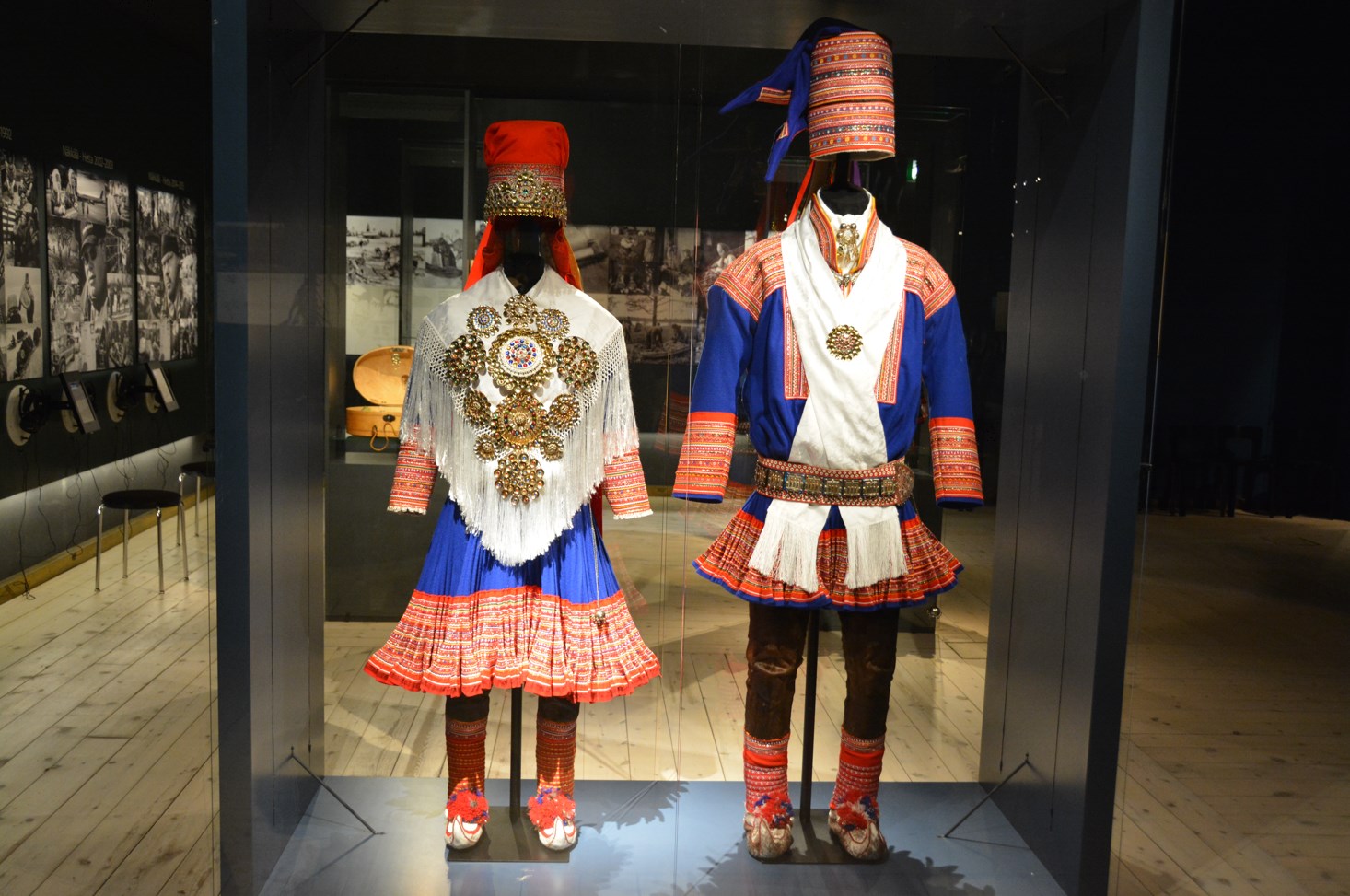The Hairy giraffe… IN CAMBODIA
This one-week journey in Cambodia was the third leg of our around-the-world tour. It was also an opportunity for us to return to Southeast Asia after a previous stay in Myanmar a few years ago.
We decided to divide our time in the country into two parts: the first dedicated to exploring Angkor and the second to Phnom Penh. We share all the details about this Khmer land adventure!
How long ? We spent 7 days in Cambodia.
When ? Early February. We aimed to avoid the monsoon season, yet daytime temperatures averaged 35 degrees Celsius at Angkor. The sky was blue, but the heat was stifling at Angkor (a bit more bearable in Phnom Penh).
Ease of independent travel: 4 giraffes ![]() Directly landing at Siem Reap airport (45 km from the city) is a significant advantage, facilitating the visit to the Angkor site. The site itself is easily explored independently, whether with a day-paid tuk-tuk, scooter, or bike. Tuk-tuks are readily available for city travel, but negotiate prices as they can be relatively high in US dollars. For budget-conscious and non-negotiation enthusiasts, Grab works well in Cambodia, accepting foreign phone numbers and cards. An efficient bus service connects different cities in the country (allowing around 6 hours to travel from Siem Reap to Phnom Penh).
Directly landing at Siem Reap airport (45 km from the city) is a significant advantage, facilitating the visit to the Angkor site. The site itself is easily explored independently, whether with a day-paid tuk-tuk, scooter, or bike. Tuk-tuks are readily available for city travel, but negotiate prices as they can be relatively high in US dollars. For budget-conscious and non-negotiation enthusiasts, Grab works well in Cambodia, accepting foreign phone numbers and cards. An efficient bus service connects different cities in the country (allowing around 6 hours to travel from Siem Reap to Phnom Penh).
Costs: 3 giraffes ![]() Tourist sites are relatively expensive in Cambodia. Grocery prices are high, sometimes approaching European or North American levels. While eating in local restaurants is still affordable, opting for more touristy places will increase expenses. All prices are in US dollars, which can add up quickly. However, hotels are very reasonably priced for the quality of rooms and services.
Tourist sites are relatively expensive in Cambodia. Grocery prices are high, sometimes approaching European or North American levels. While eating in local restaurants is still affordable, opting for more touristy places will increase expenses. All prices are in US dollars, which can add up quickly. However, hotels are very reasonably priced for the quality of rooms and services.
Ease of communication : 3 giraffes ![]() Most tourist facilities (sites, hotels, transportation) accommodate you with decent English. Occasionally, you might find Cambodians (often older individuals) who speak French. However, don’t expect advanced conversations in Shakespeare’s language.
Most tourist facilities (sites, hotels, transportation) accommodate you with decent English. Occasionally, you might find Cambodians (often older individuals) who speak French. However, don’t expect advanced conversations in Shakespeare’s language.
Safety: 4 giraffes ![]() We never felt insecure during the journey. However, particularly in Phnom Penh, snatch-and-grab thefts can happen. Basic precautions should be observed to avoid any issues without succumbing to paranoia.
We never felt insecure during the journey. However, particularly in Phnom Penh, snatch-and-grab thefts can happen. Basic precautions should be observed to avoid any issues without succumbing to paranoia.
Health: 3 giraffes ![]() Despite Cambodia’s recent economic development, the healthcare system can be somewhat approximate. Finding a competent doctor in Phnom Penh and Siem Reap is relatively easy, but it might differ in rural areas. There’s a chance of encountering French-speaking doctors or pharmacists in Phnom Penh (Cambodia was a French protectorate until 1953). The water is not potable, but the health situation is far from catastrophic, and dining in many restaurants poses no risk of food poisoning.
Despite Cambodia’s recent economic development, the healthcare system can be somewhat approximate. Finding a competent doctor in Phnom Penh and Siem Reap is relatively easy, but it might differ in rural areas. There’s a chance of encountering French-speaking doctors or pharmacists in Phnom Penh (Cambodia was a French protectorate until 1953). The water is not potable, but the health situation is far from catastrophic, and dining in many restaurants poses no risk of food poisoning.
Gay friendly: 3 giraffes ![]() Homosexual relationships are allowed and have never been prohibited throughout the country’s history. However, LGBT+ rights remain limited, and public displays of affection, even for heterosexual couples, are discreet.
Homosexual relationships are allowed and have never been prohibited throughout the country’s history. However, LGBT+ rights remain limited, and public displays of affection, even for heterosexual couples, are discreet.
Travel ease: 4 giraffes ![]() No particular issues visiting this country, except for the absence of direct flights from Europe.
No particular issues visiting this country, except for the absence of direct flights from Europe.
Highlights: ![]() Angkor, especially the temples of Ta Prohm and Bayon, and the kindness and smiles of the Cambodian people.
Angkor, especially the temples of Ta Prohm and Bayon, and the kindness and smiles of the Cambodian people.
Letdowns: ![]() The Angkor Wat temple, whose empty interior doesn’t quite match the exterior’s grandeur (still beautiful but not our favorite), the sometimes overwhelming heat even in February, and even after sunset.
The Angkor Wat temple, whose empty interior doesn’t quite match the exterior’s grandeur (still beautiful but not our favorite), the sometimes overwhelming heat even in February, and even after sunset.
Despite advice to not stay in Phnom Penh due to its perceived lack of attractions, the Cambodian capital was far from a disappointment for us. The sites are pricey, but you can spend a few days without getting bored.
Check out our Travel Reflections articles on Cambodia:
ONE-WEEK ITINERARY IN CAMBODIA
Here is the detailed itinerary of our week in Cambodia:
Day 0: A flight of just over an hour from Bangkok to Siem Reap. We arrive at the hotel in the late afternoon, just in time to enjoy the complimentary tea, the pool, and to purchase our 3-day ticket for Angkor online.
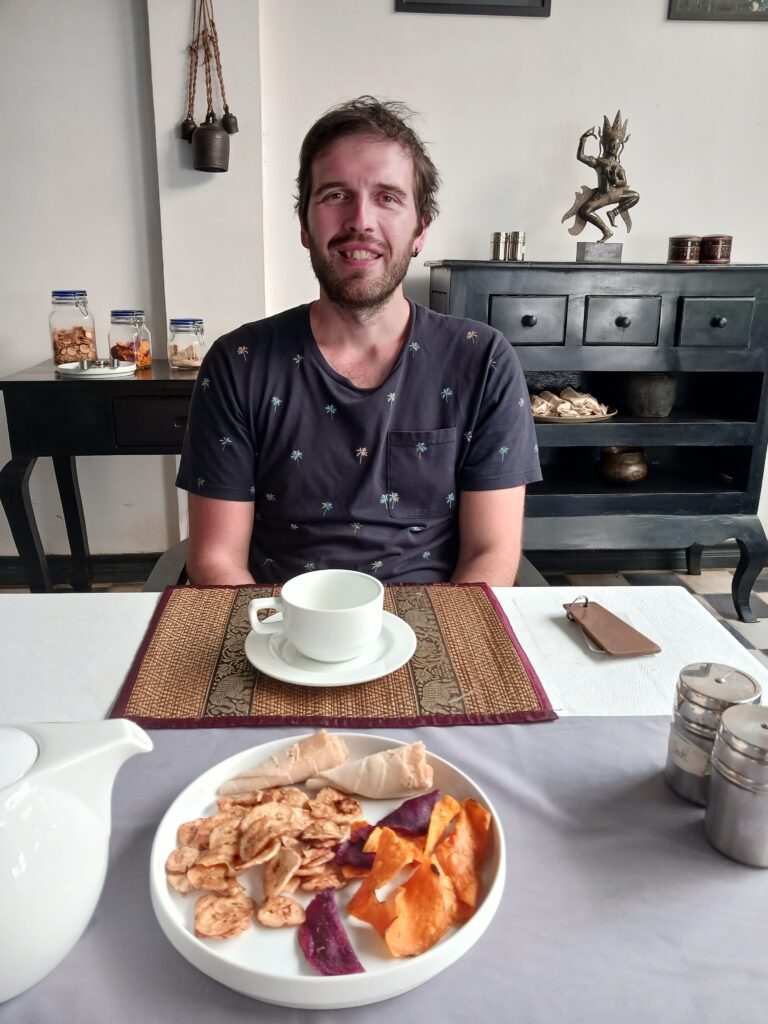

Day 1: We hop on our off-road bikes rented from the hotel at 7 am to explore Angkor. Opting for bikes over scooters due to our previous experience in Myanmar, on this first day, we decide to travel a portion of the “small loop” in an anti-clockwise direction to minimize encounters with tourist buses. At Angkor, there are indeed two possible routes: the small loop, passing by the most famous temples, and the grand loop, an extension offering views of less-known temples.
We start with the Benteay Kdei temple, a typical representation of what one envisions in Angkor with ruins and vegetation everywhere. A truly captivating beginning!



Our exploration continues with Ta Prohm. This temple, with its decor resembling a video game, is simply stunning and ends up being our favorite. Visiting early in the morning allows us to avoid crowds and practically have the site to ourselves.

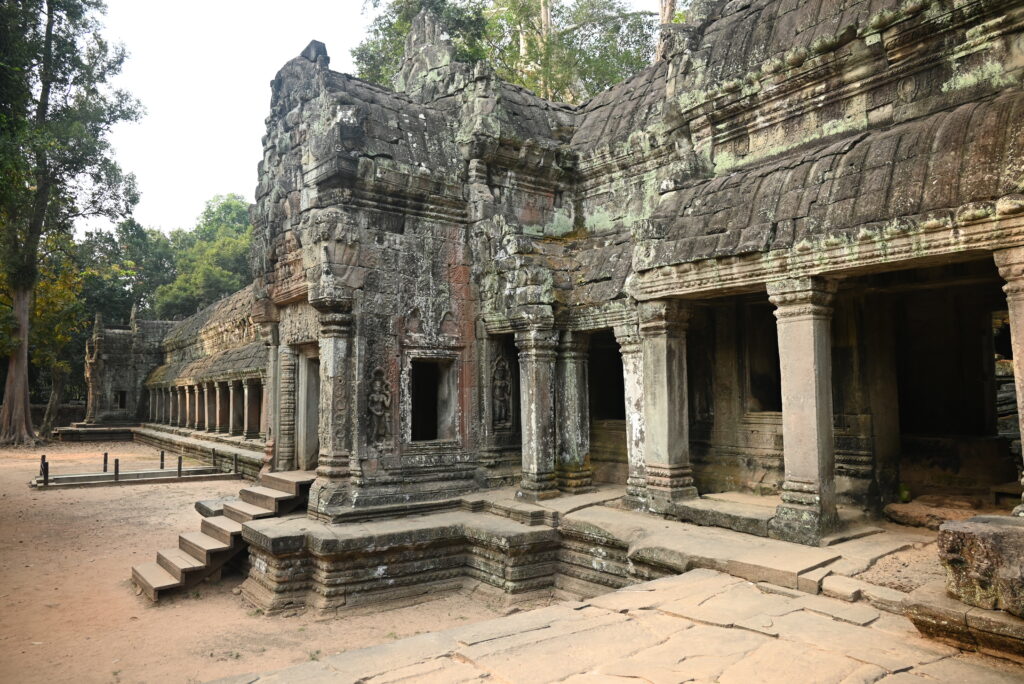


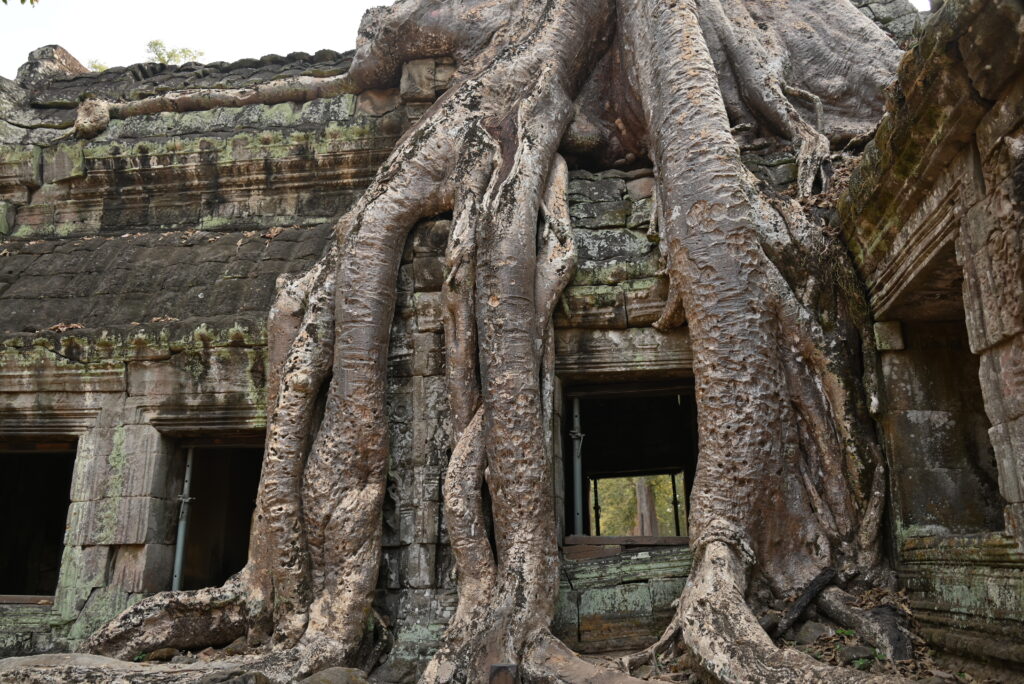
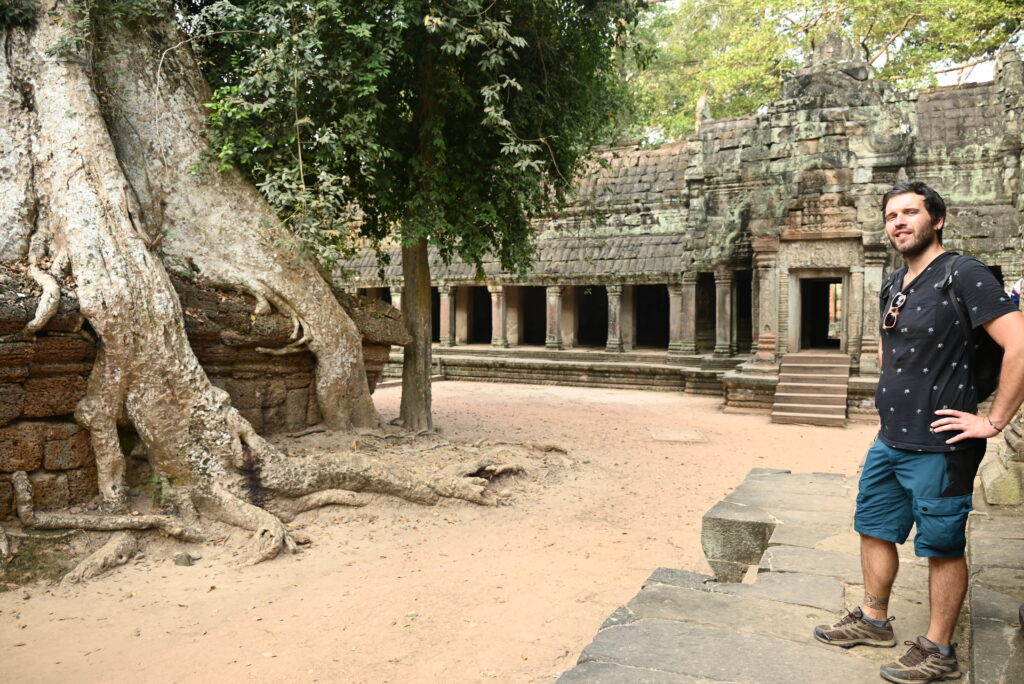
A cycling path winding through the trees leads us to Ta Keo. We ascend its steep steps to reach the summit and enjoy the panoramic view.


We then resume biking to the Ta Nei temple, another beautiful blend of ruins and nature, before picnicking on the banks of the Jayatataka Baray, without much interest.

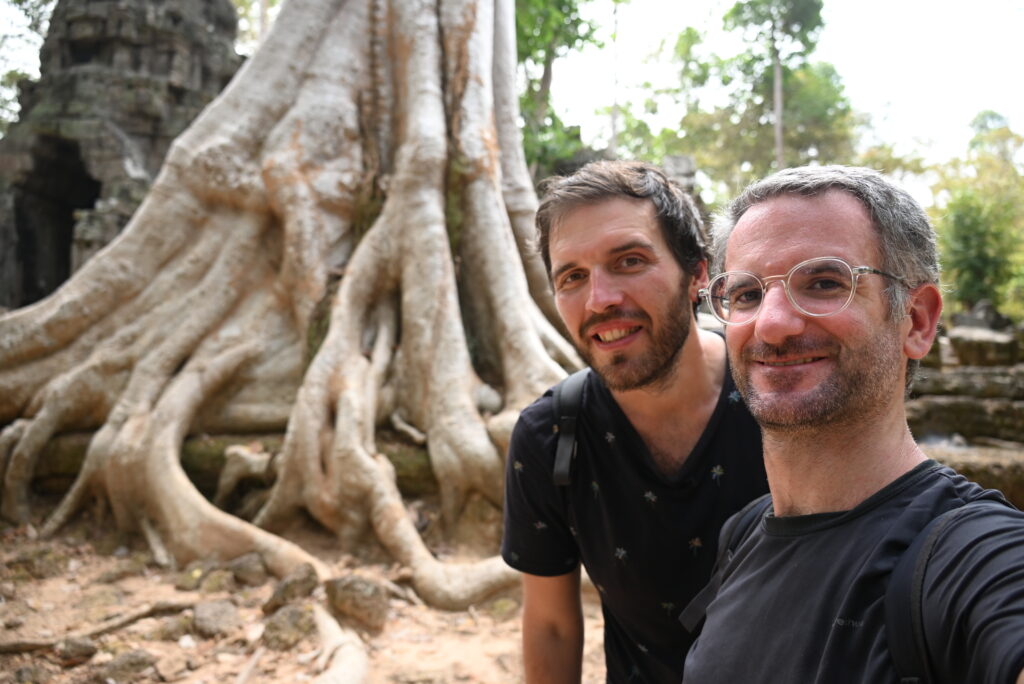


Next, we take a break for souvenirs and refreshments at one of the many shops in front of Thommanon and Chau Say Tevoda temples. While the first showcases lovely bas-reliefs and is worth a visit, the second is more anecdotal due to its lesser preservation.

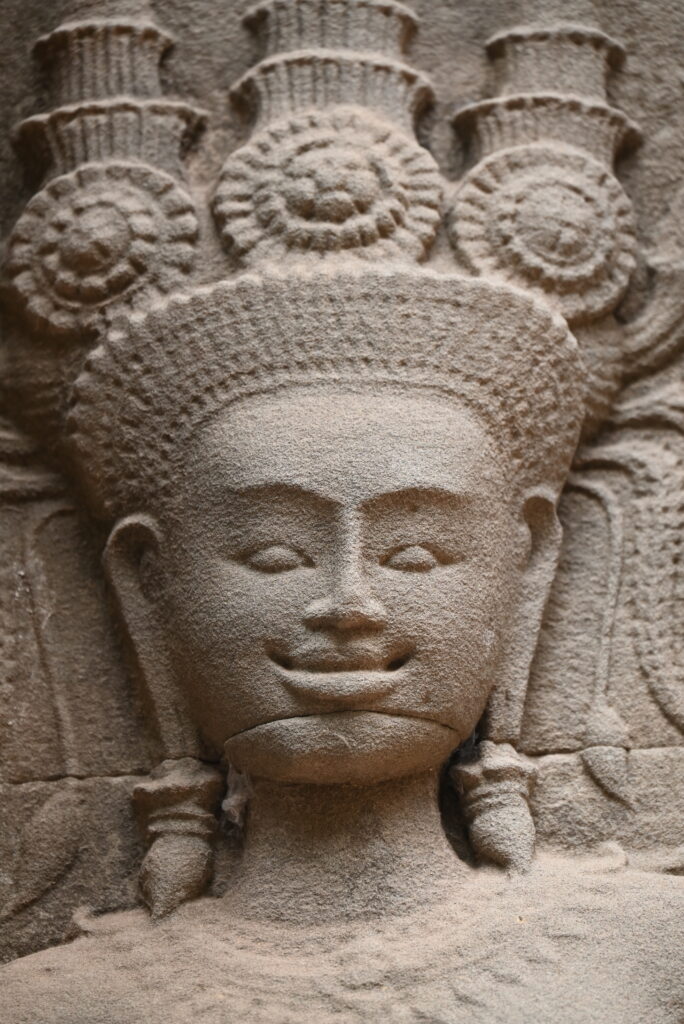
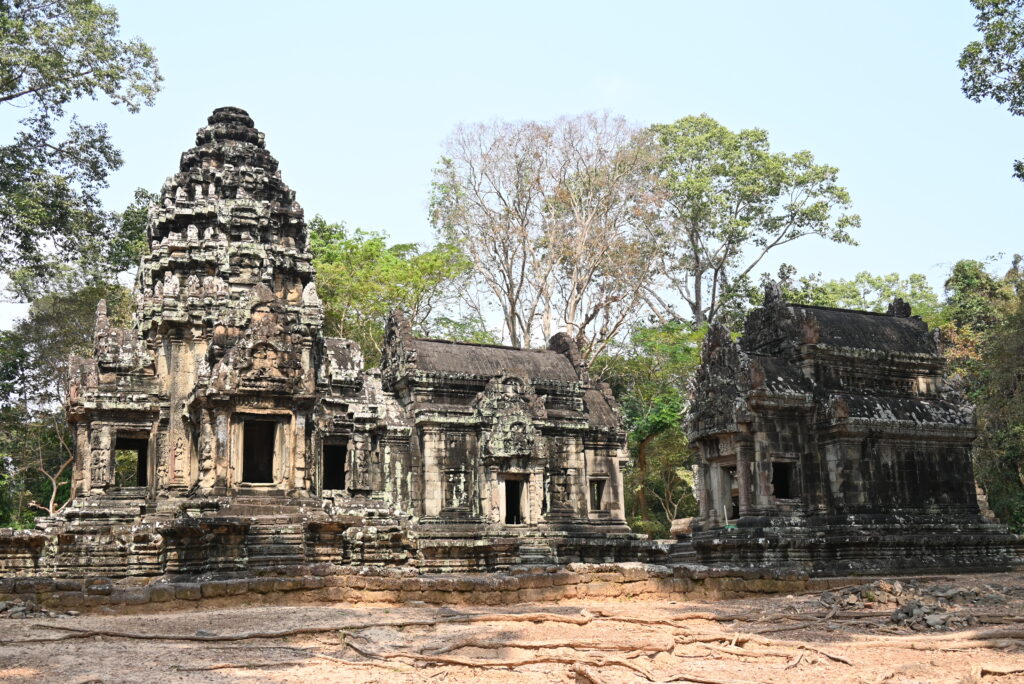
Continuing our day at the Preah Pithu complex, we explore it briefly before crossing the road to see the Terrace of the Leper King, adorned with magnificent bas-reliefs featuring elephants.
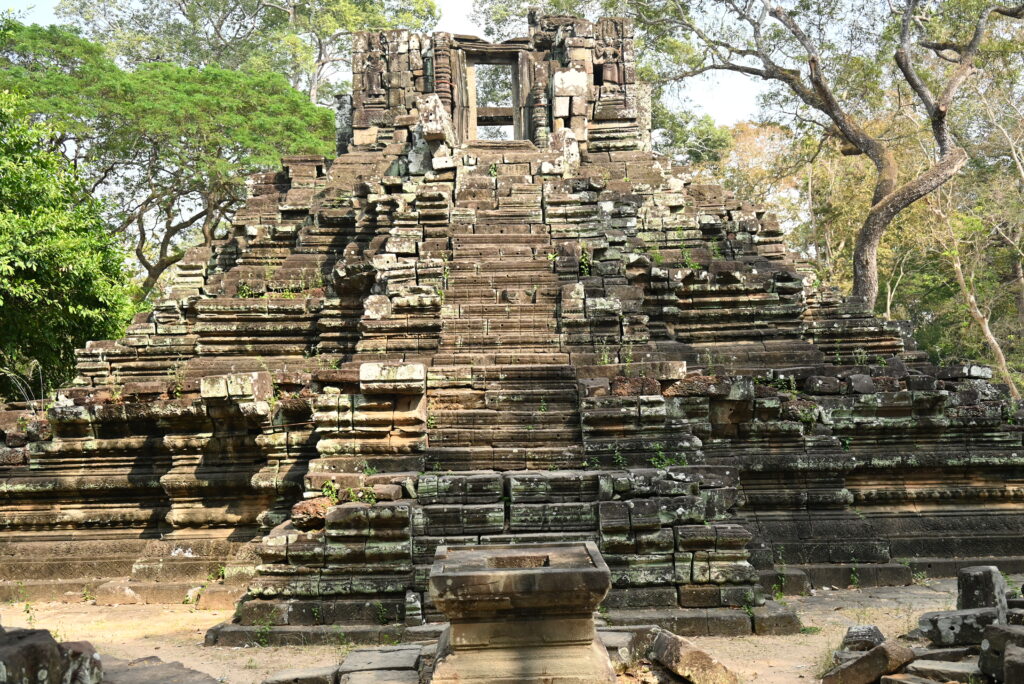
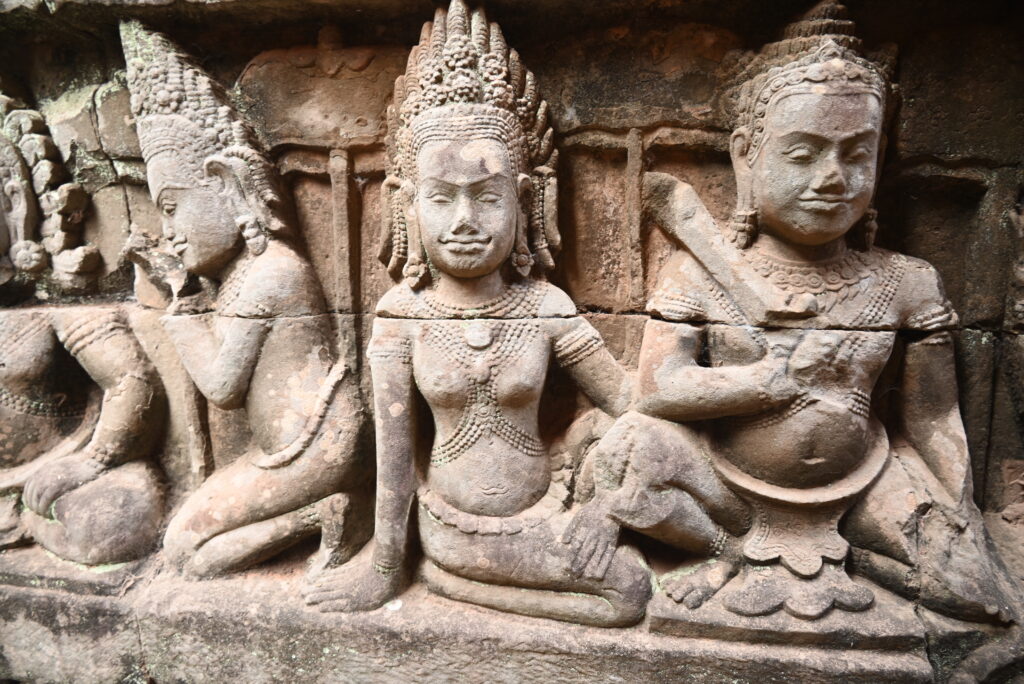

After a brief stop near Bayon to capture photos of the monkey colony, the day concludes in front of Angkor Wat.
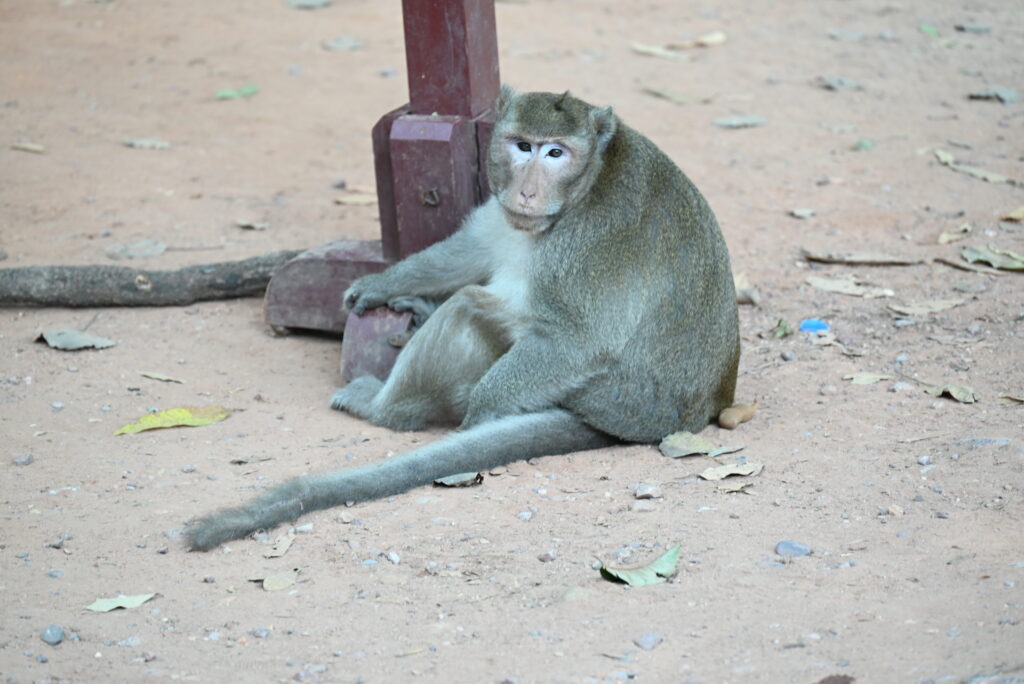
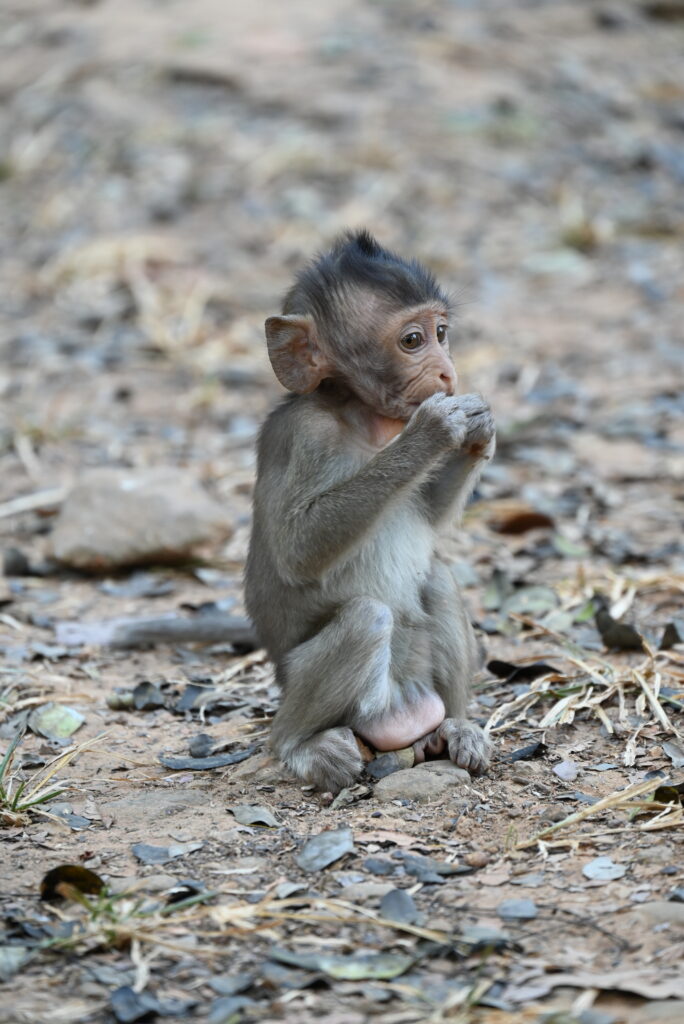
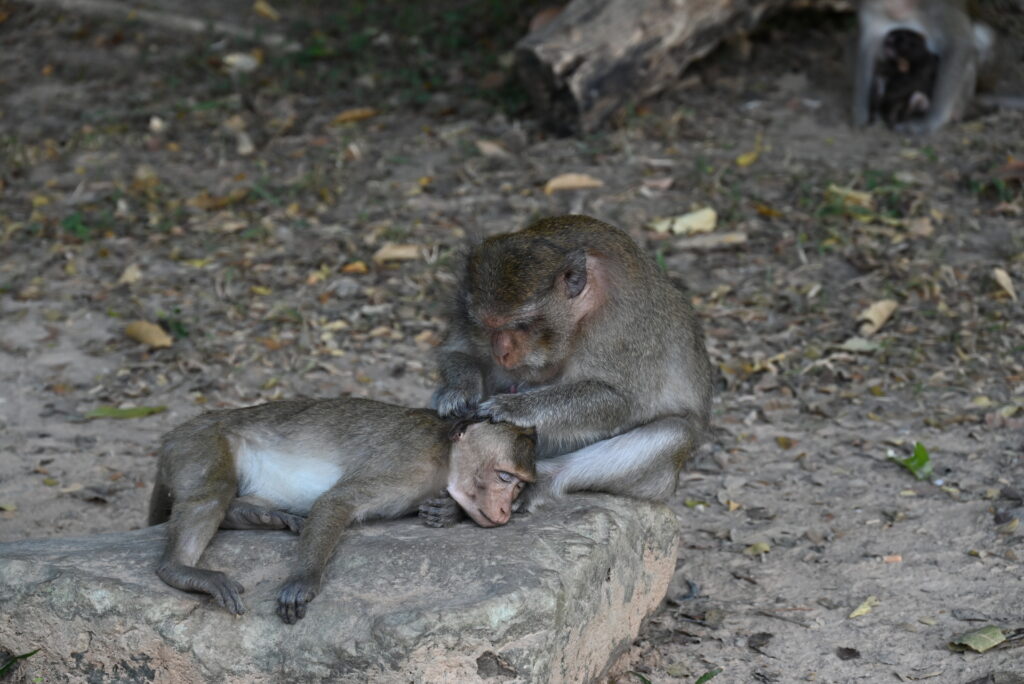
The evening light is perfect for admiring the temple from the riverbank near the west gate. As François struggles with the heat, we postpone the temple visit to another day.


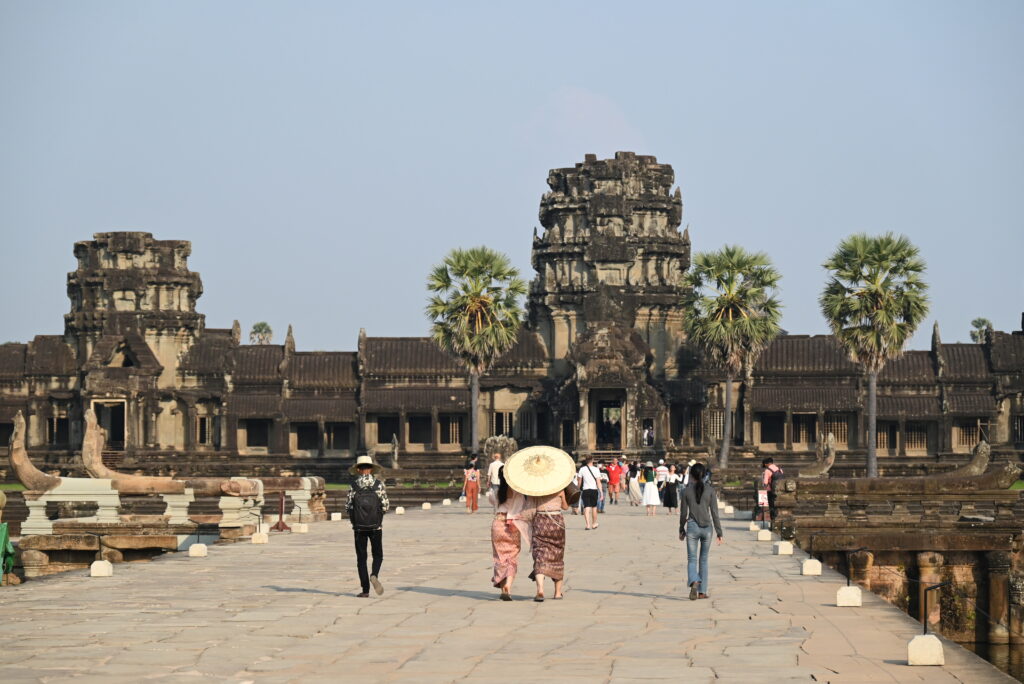

After covering 42 km and nearly 11 hours of biking, we return, sweaty, to enjoy the hotel’s pool.
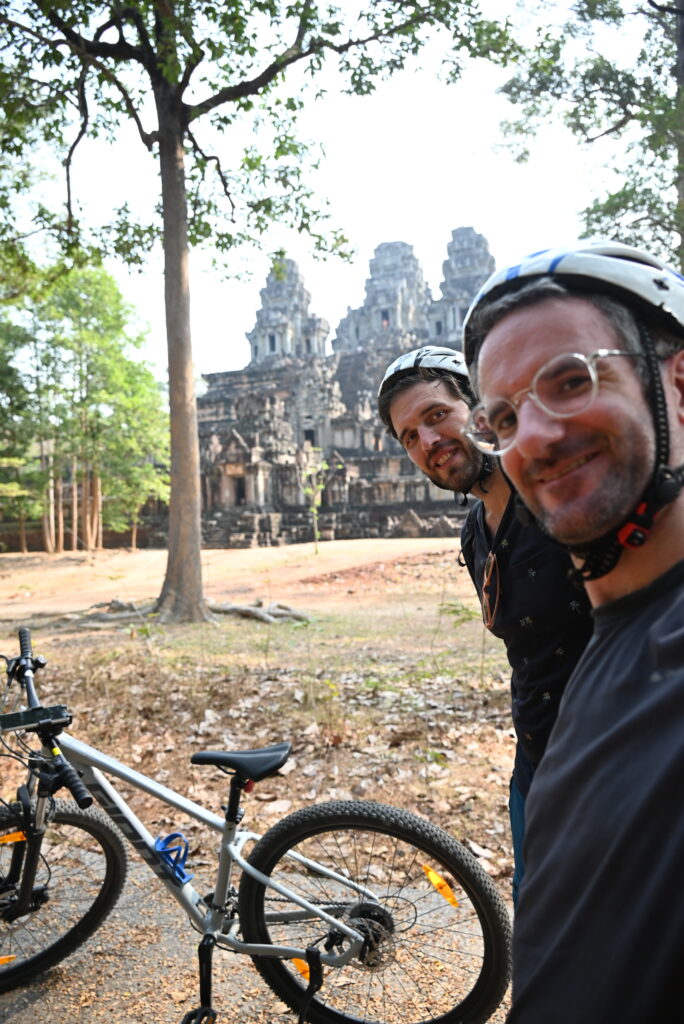

Day 2: The 11 hours of cycling and yesterday’s heat have left us a bit exhausted. We decide to start later and ride less. We retrieve our bikes at 10 am and set off, this time heading towards the big loop. We plan to only do the western part, saving the rest for the next day..
Our first stop is the Phnom Bakheng temple atop a steep hill. Our muscle soreness makes the ascent more challenging. In clear weather, the temple should offer a lovely view, but all we get is limited visibility due to the morning mist. Disappointed, we descend, considering the temple is also under construction.

Taking advantage of the fact that the heat hasn’t peaked yet, we head towards Preah Khan.


We then descend the road to Benteay Prei, a beautiful temple.

We pass by the Phimeanakas and Baphûon temples…

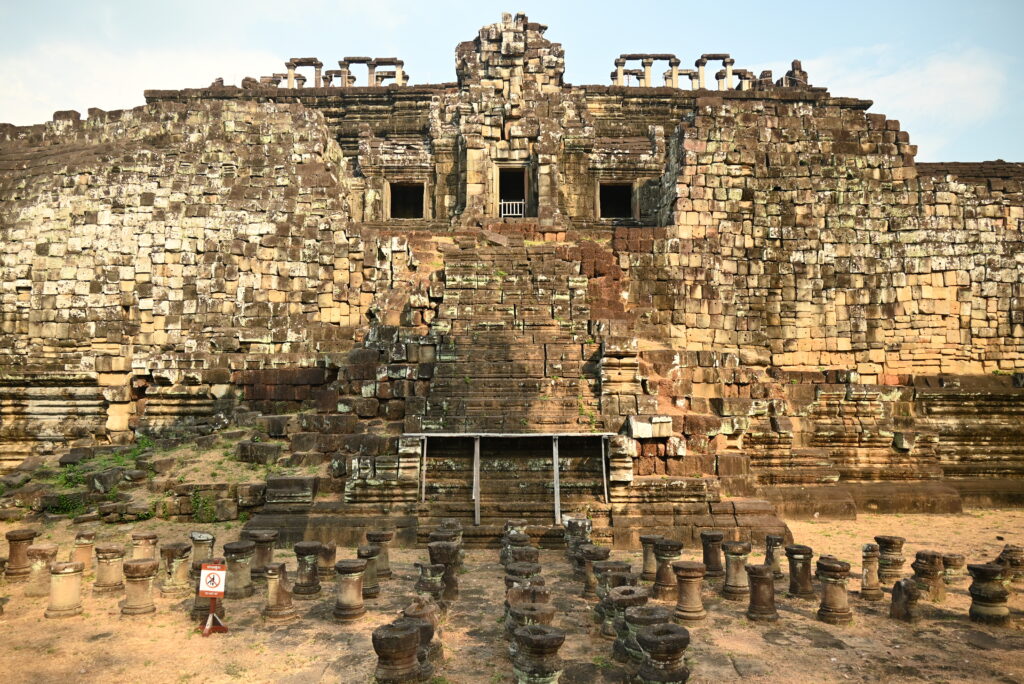
…before finishing the day at Bayon after regaining some strength (this time, Benjamin struggles with the heat). The late afternoon light highlights the immense sculpted heads of the temple, and we are almost alone.
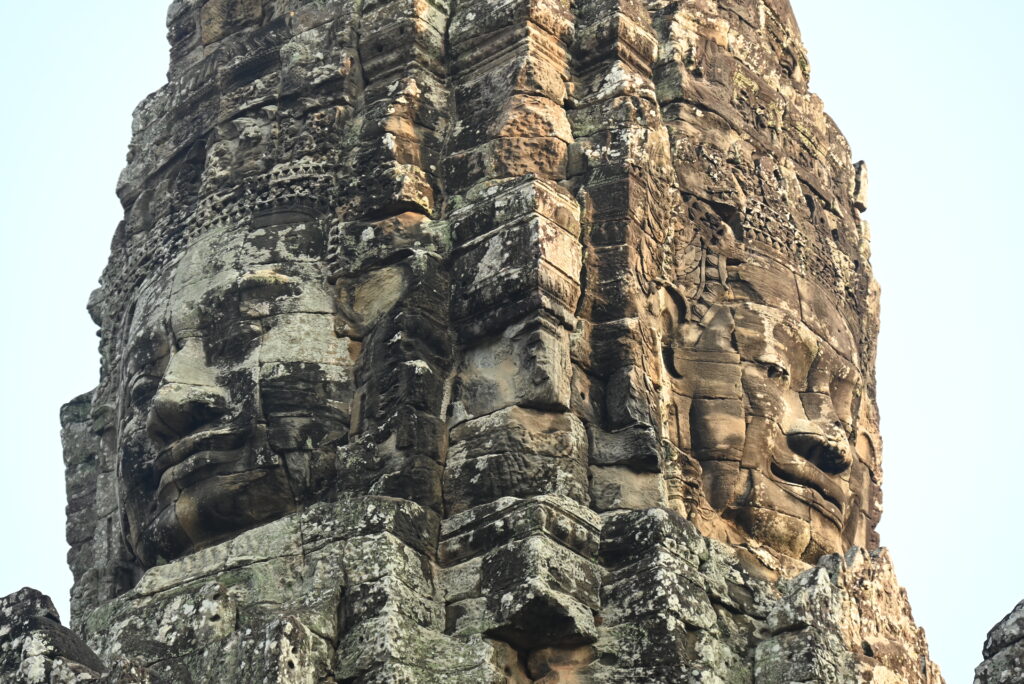
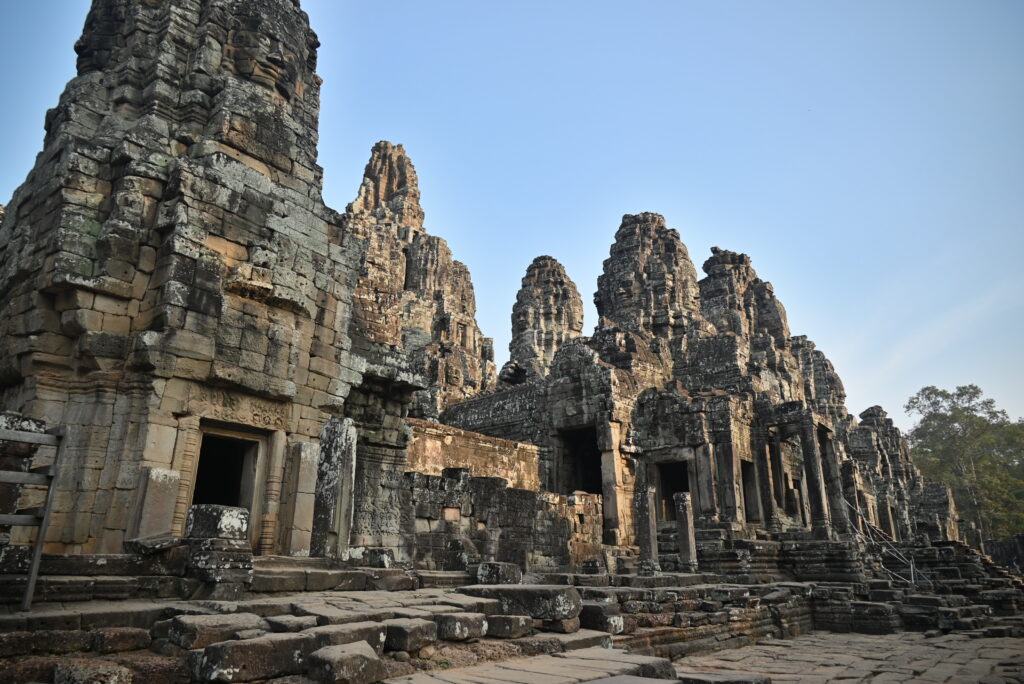
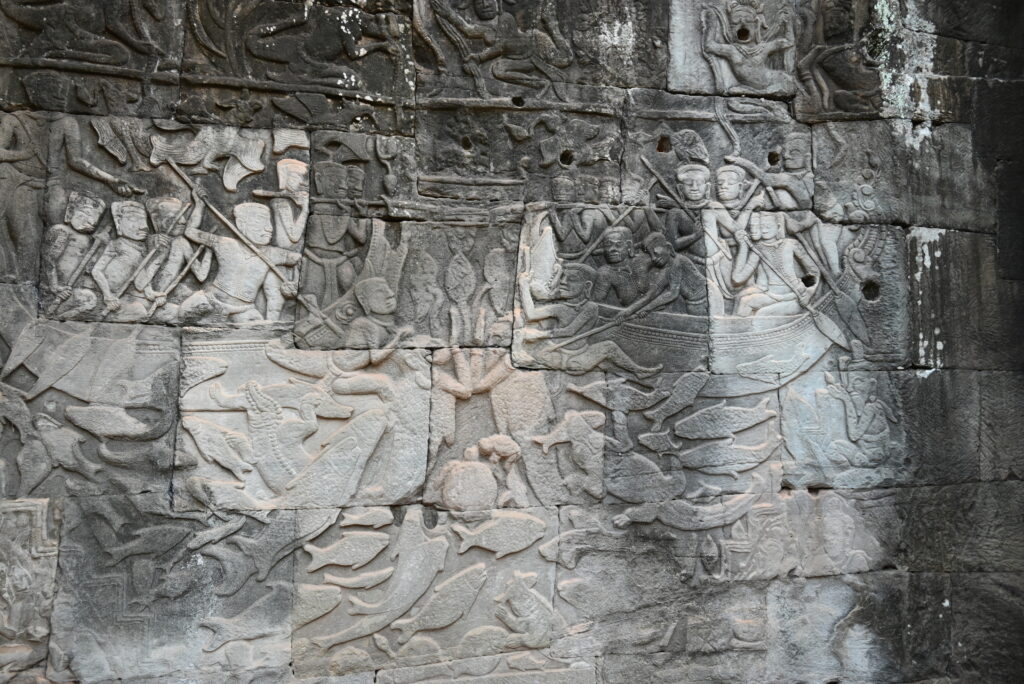


In the end, we covered about 52 km that day, far from our plan to ride less than the previous day. It’s possible to do the big loop in one day by bike, but it leaves little time for sightseeing.
Day 3: Our last day in Angkor begins at 8 am to take advantage of the morning “coolness” for the journey. We stop at Angkor Wat, entering through the east gate. Surprisingly, there are few tourists around (contrary to most blogs that advised against visiting this temple in the morning due to crowds). The visit is relatively quick. Many sculptures are damaged, and some walls sadly bear engravings from tourists. Ultimately, the temple has much less charm than others we’ve seen before, like Ta Prohm or Bayon.
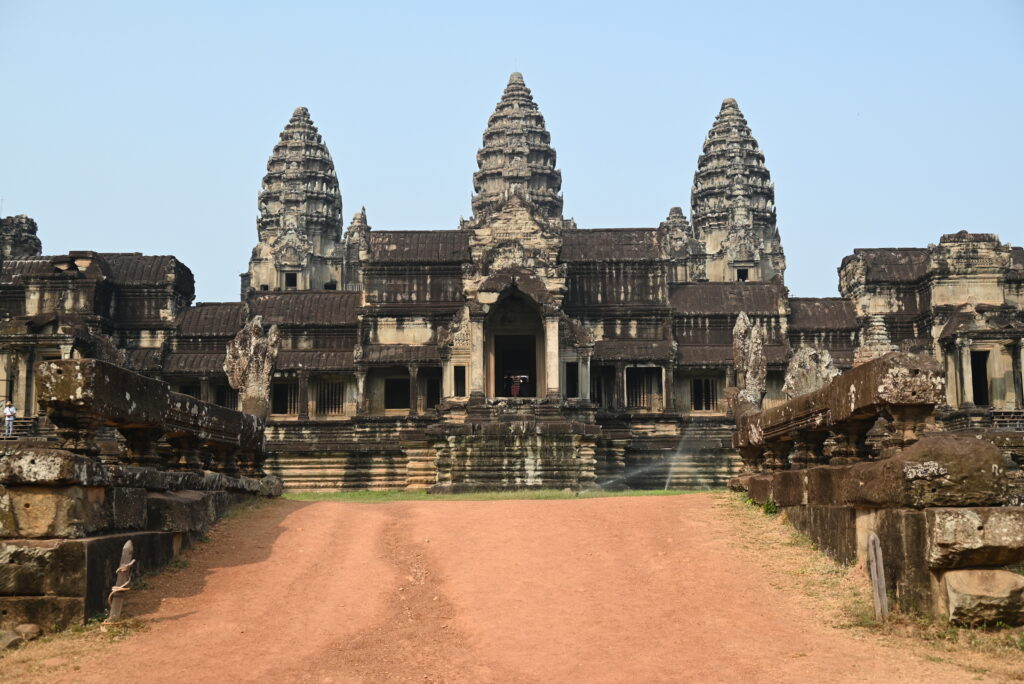




Next, we take the east branch of the big loop and start with Prasat Kravan. This temple is on the road, easy to visit, and features a beautiful statue of Vishnu and stunning bas-reliefs.


We then ride to Bat Chum temple. A pointless detour as the temple is so damaged, covered in scaffolding, and inaccessible.
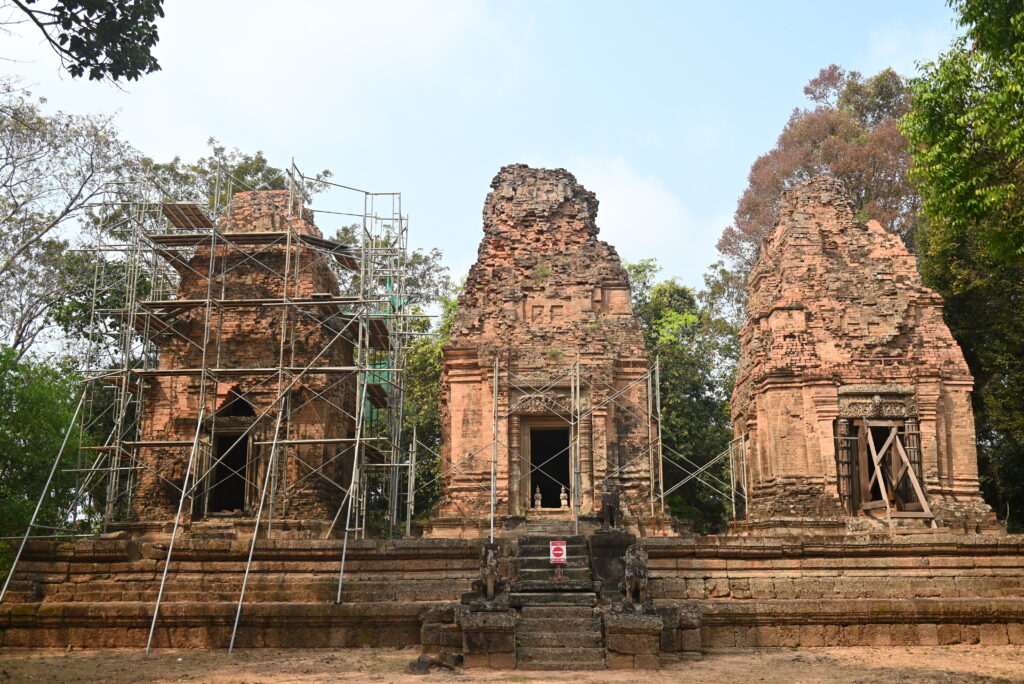
The following temple is Pre Rup, another elevated temple with a slightly perilous ascent due to narrow steps.

Afterward, we cycle to Ta Som, another beautiful temple whose ruins are engulfed by tree roots. It’s a shame the tree above the east gate has been cut. We buy some souvenirs from local artisans before moving on.




Descending towards East Mebon, the temple is magnificent with its enormous elephants at the four corners.

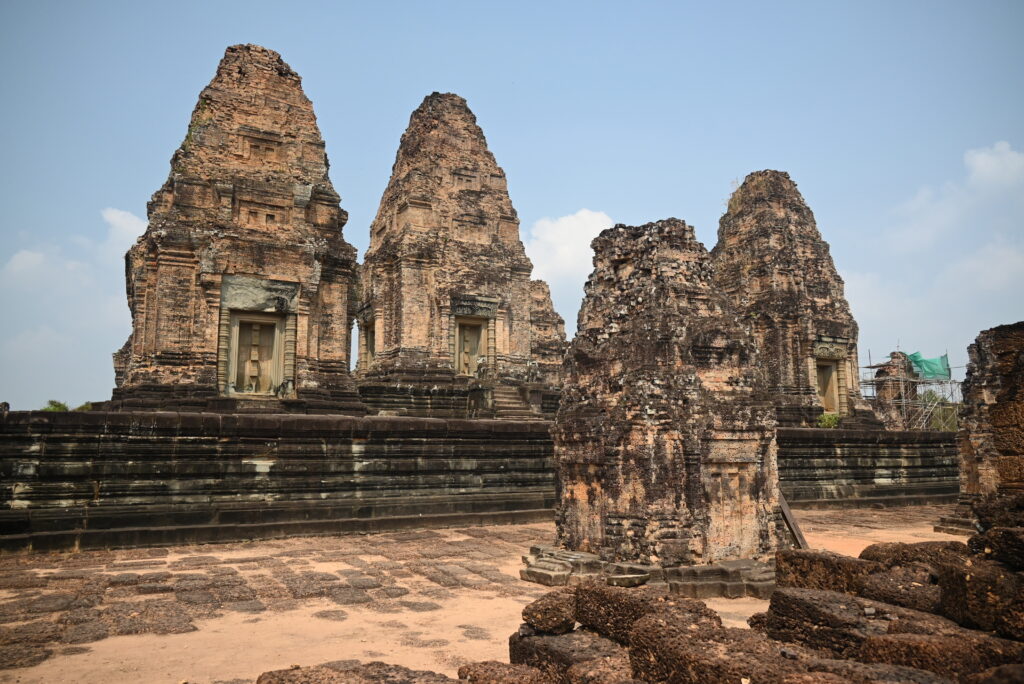
We conclude the day (and our time in Angkor) by returning to Ta Prohm, visited two days earlier. After seeing over twenty temples, it’s undoubtedly our favorite.

A final day with over 50 km of cycling. It’s official: we no longer feel our buttocks!
Day 4: We take the bus to Phnom Penh where we arrive in the late afternoon (the journey will have lasted 6 hours and 30 minutes).

Day 5: We’ve planned a very interesting yet not cheerful day. We begin by visiting the Tuol Sleng Genocide Museum. With our audio guide in our ears, we navigate through this former Khmer Rouge prison. We listen to a Cambodian from a tortured family at this site recount all the horrors committed by supporters of the Pol Pot regime. Some parts are difficult to hear.
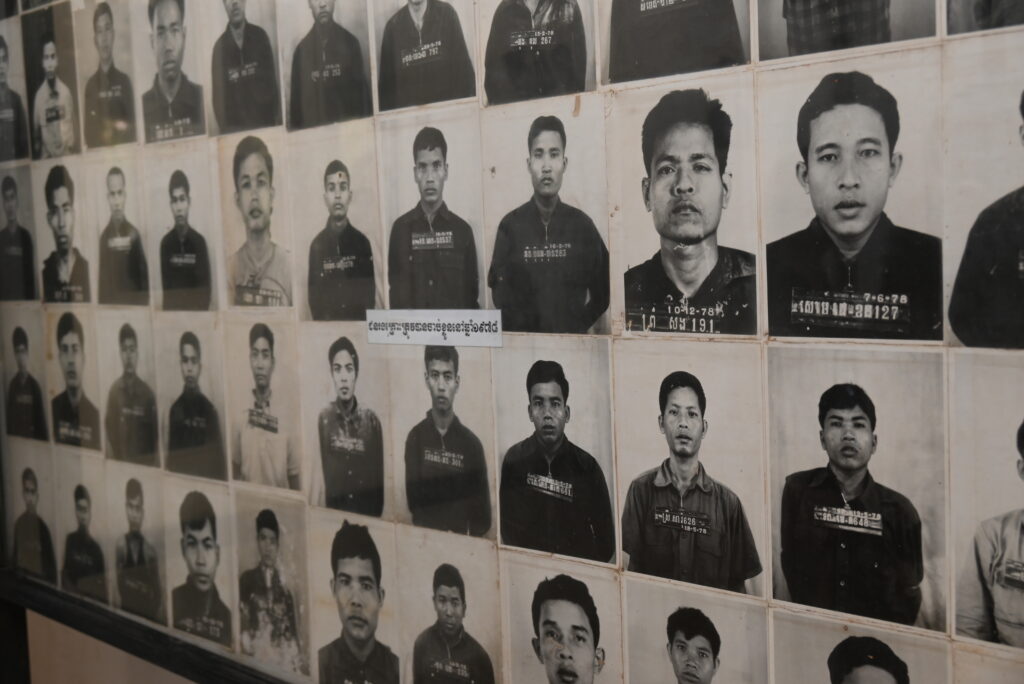
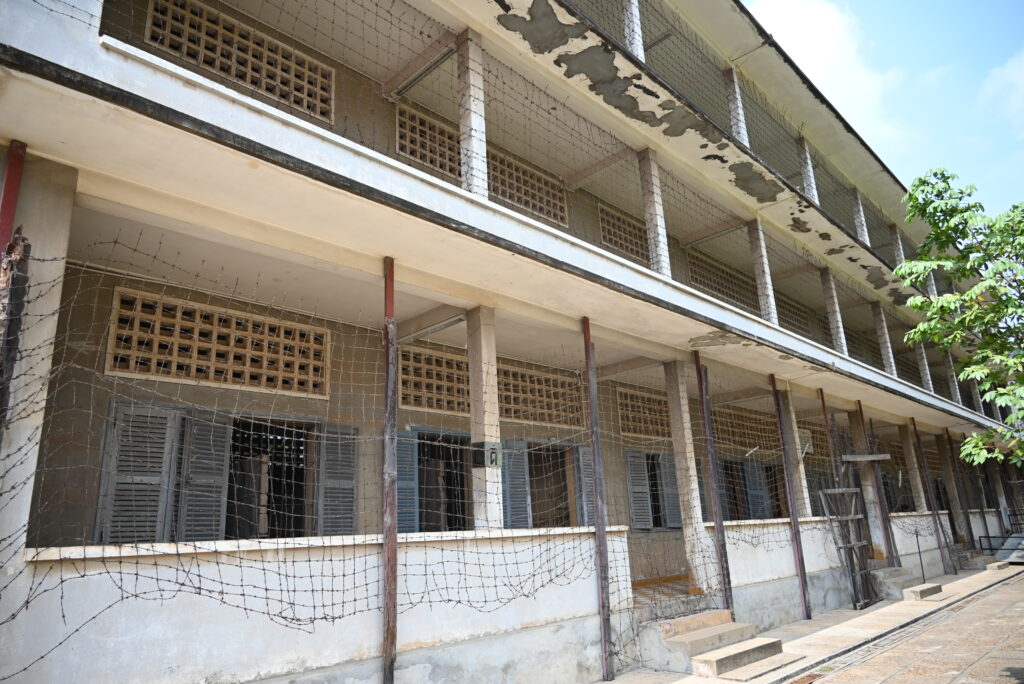


To lighten the mood, we walk to the Russian market where several shops are closed due to the Chinese New Year, but that doesn’t stop us from making a few purchases…



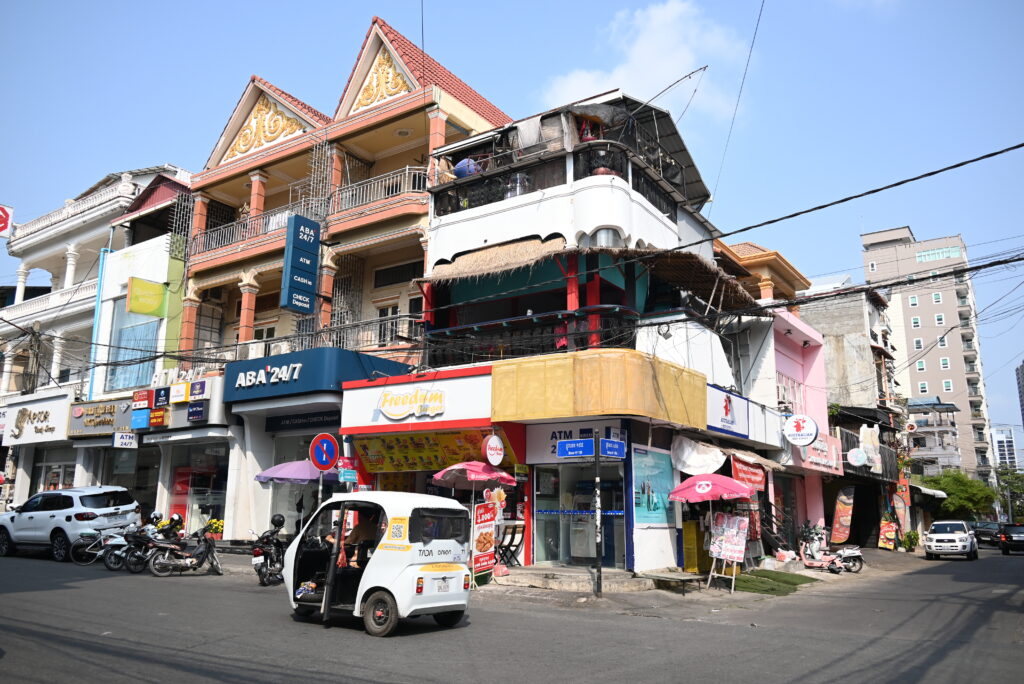

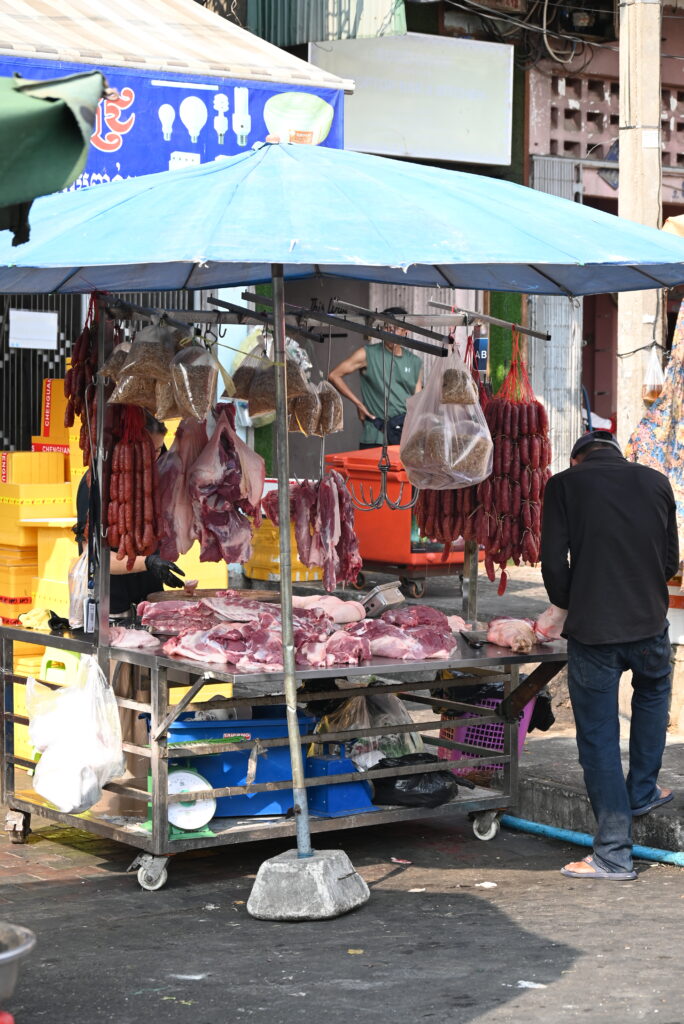
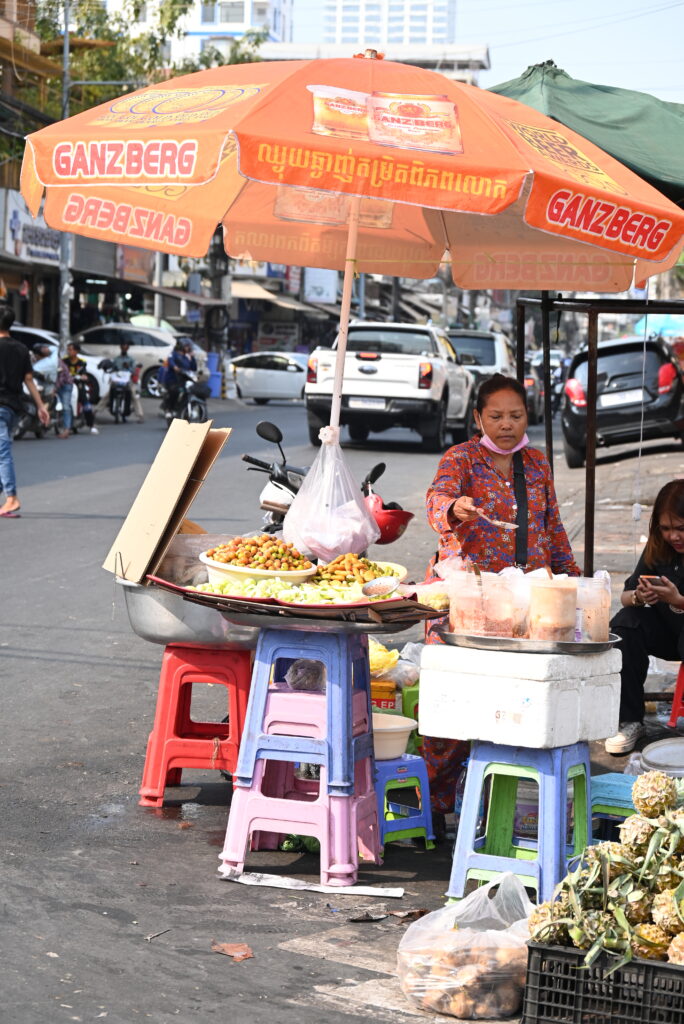
We then head to the Choeung Ek Killing Fields. Since many original buildings were destroyed at the end of the Khmer Rouge regime, the site is, at first glance, less figurative than Tuol Sleng. Nevertheless, the presence of fabric scraps and bones of victims emerging from the ground after rains, along with the stupa filled with human skulls, is shocking and thought-provoking.
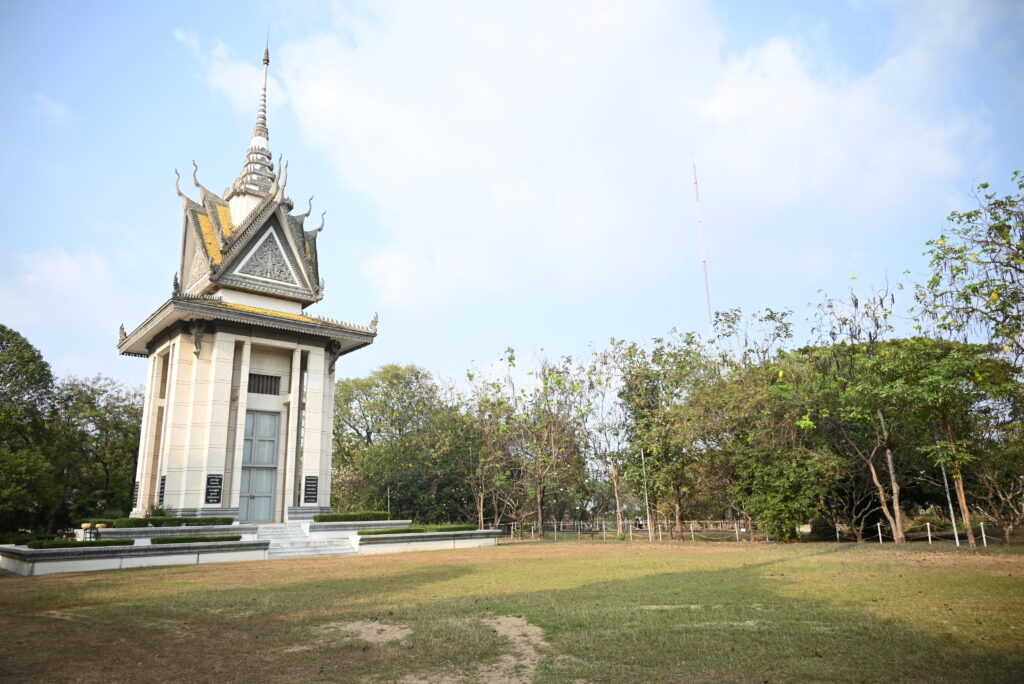

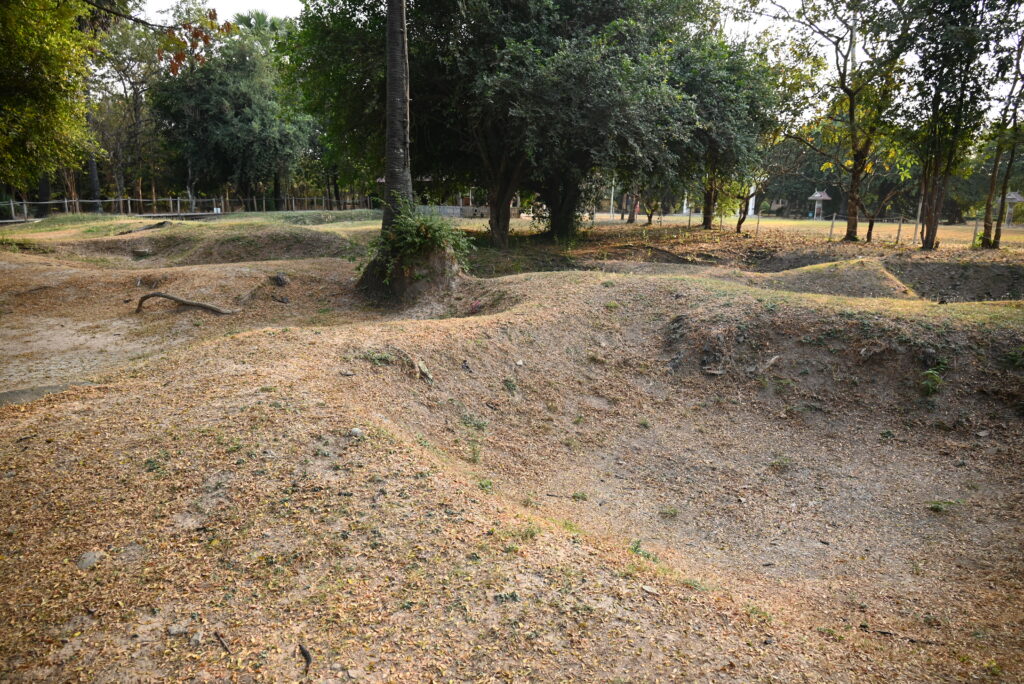

Day 6: We continue our exploration of Phnom Penh with a stroll through the streets around the Central Market, showcasing Art Deco style. Then, we continue our walk to the banks of the Mekong River.

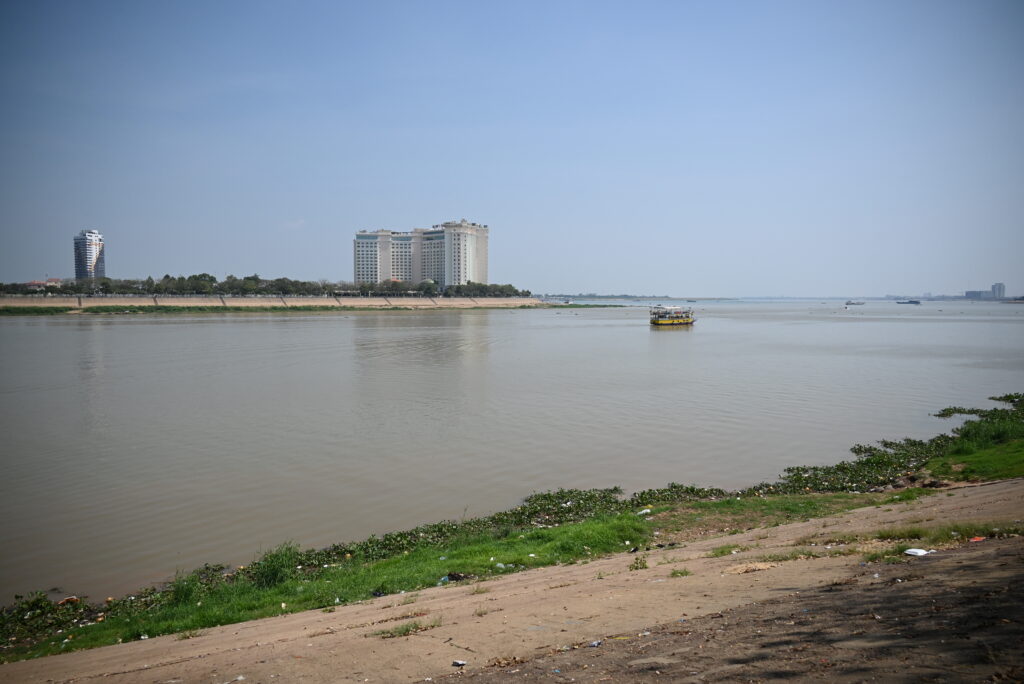


We visit the nearby Wat Ounalom monastery.
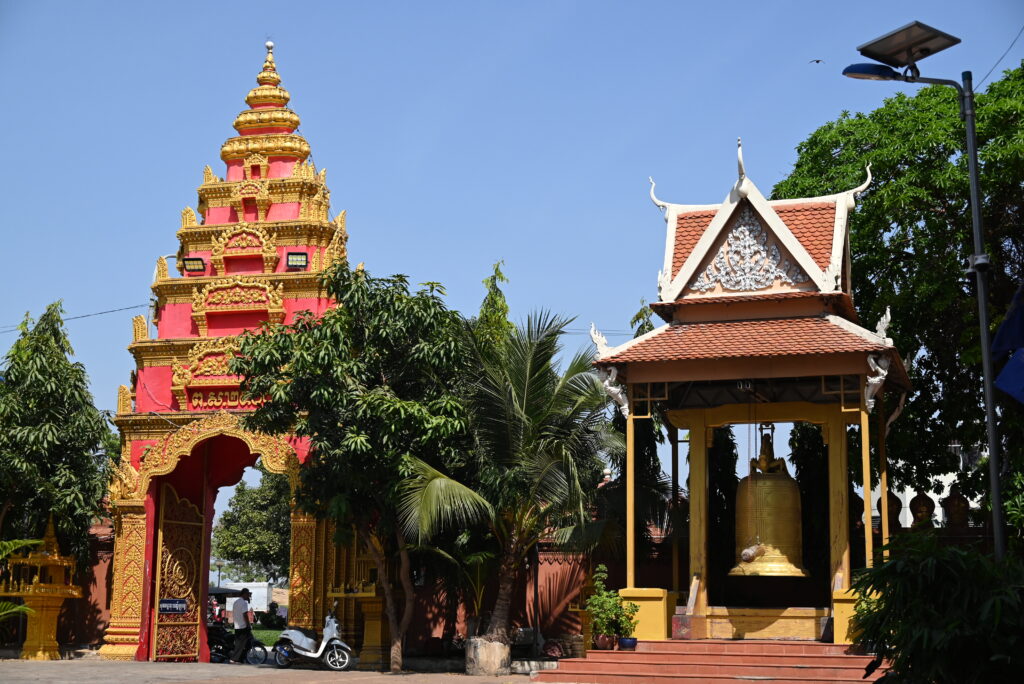

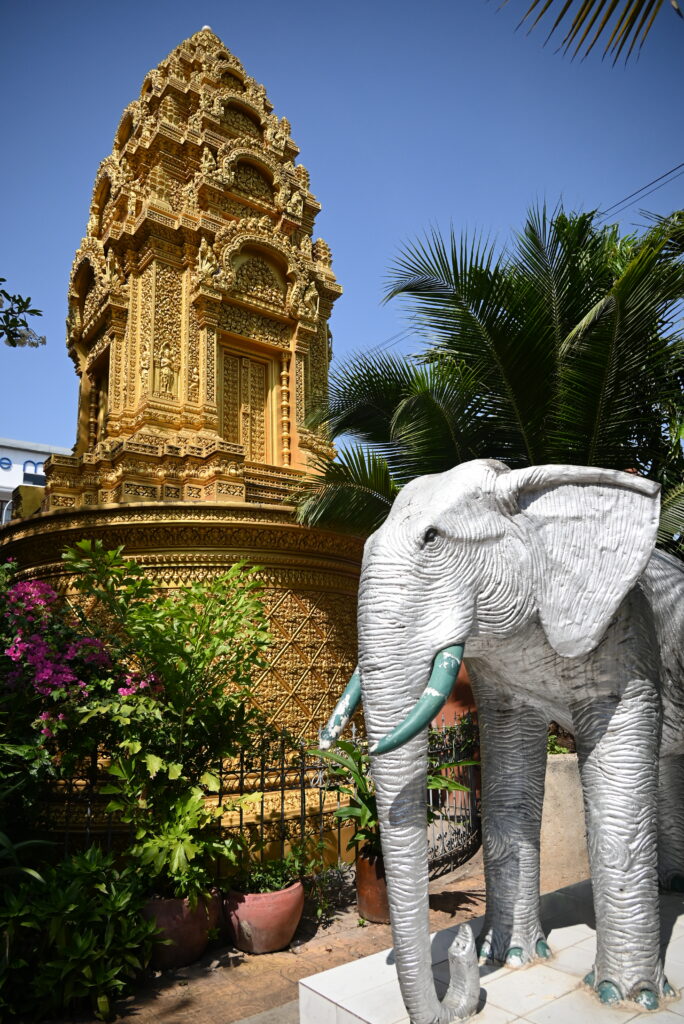
Next, we head to the Royal Palace. Beautiful and golden, although it’s hard not to compare it to the one in Bangkok, where we were not too long ago, which is much more lavish and colorful.
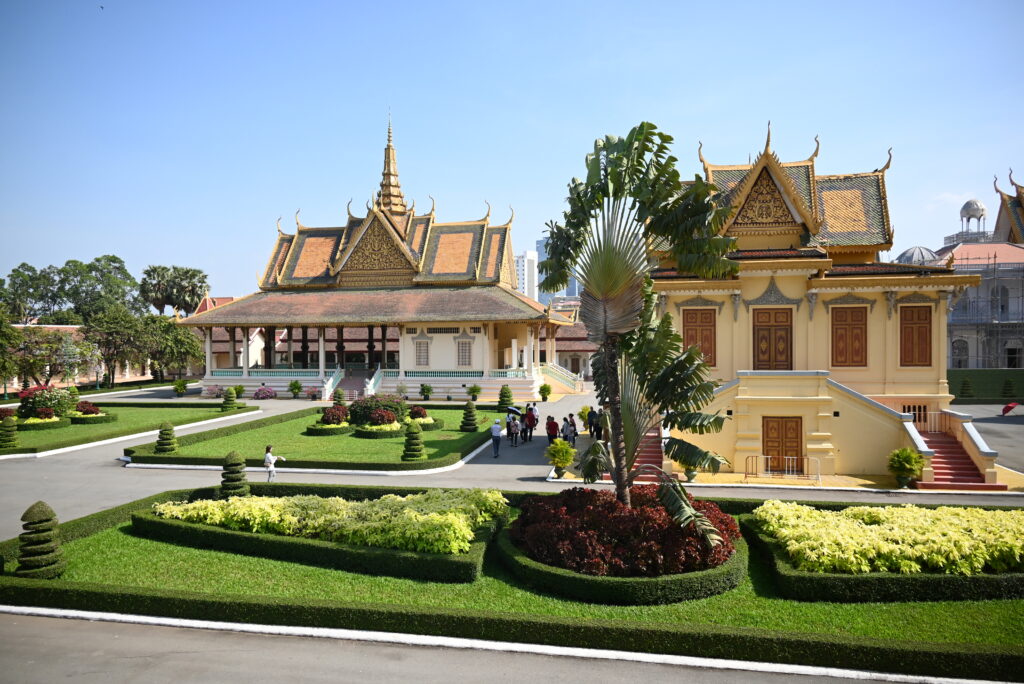



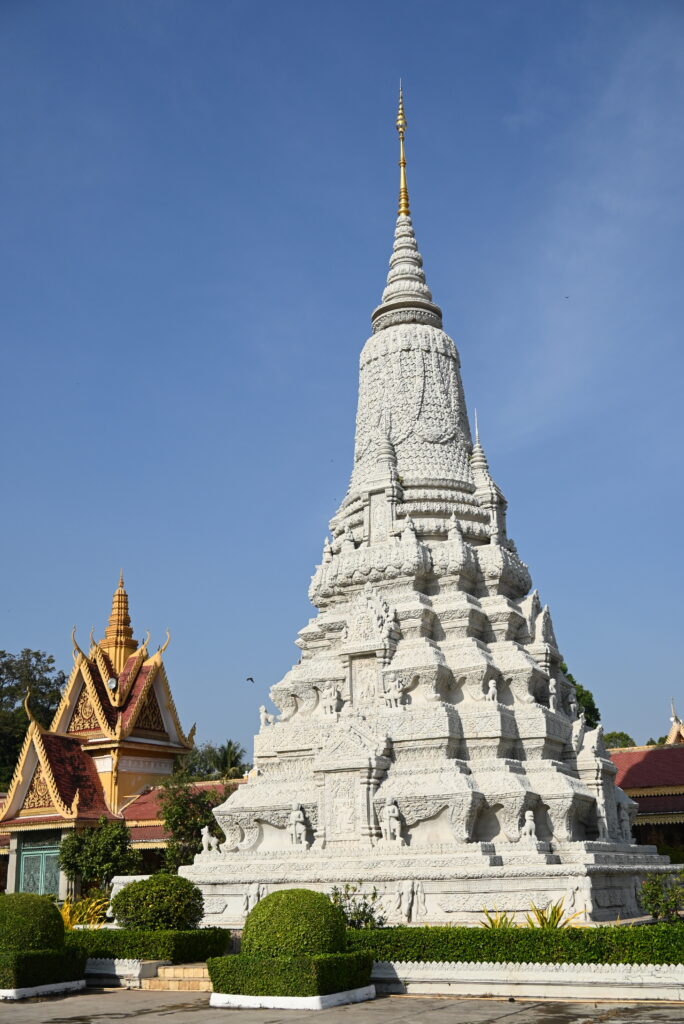
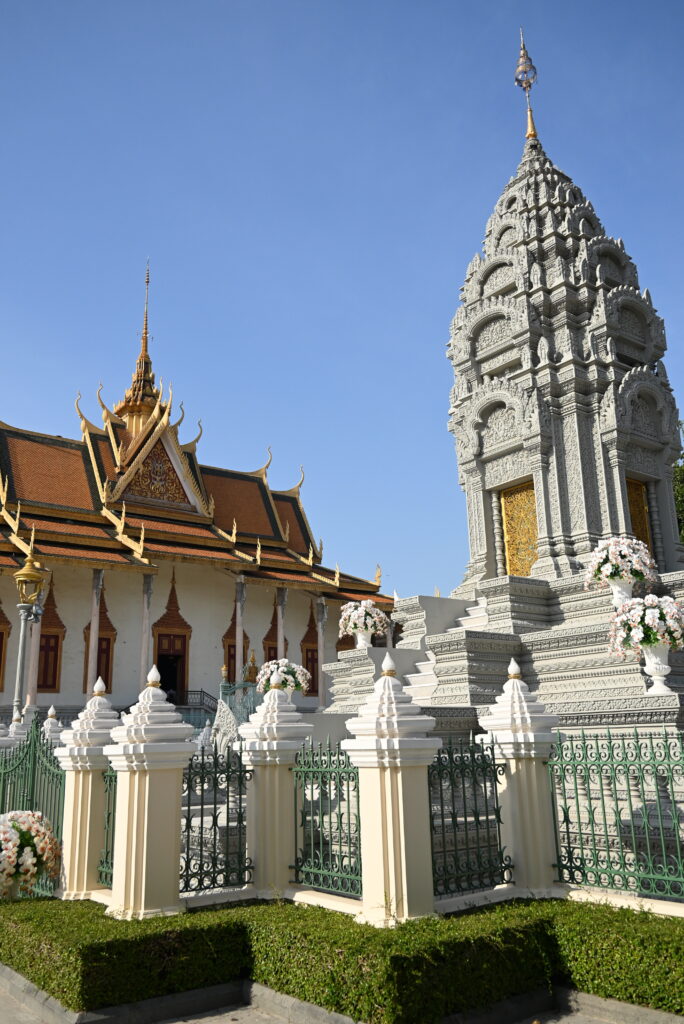
We conclude the day at Wat Phnom temple amid the festivities of the Chinese New Year. This temple is linked to the name of the Cambodian capital, as legend has it that Madame Penh found Buddha statues at the base of this Phnom (hill).
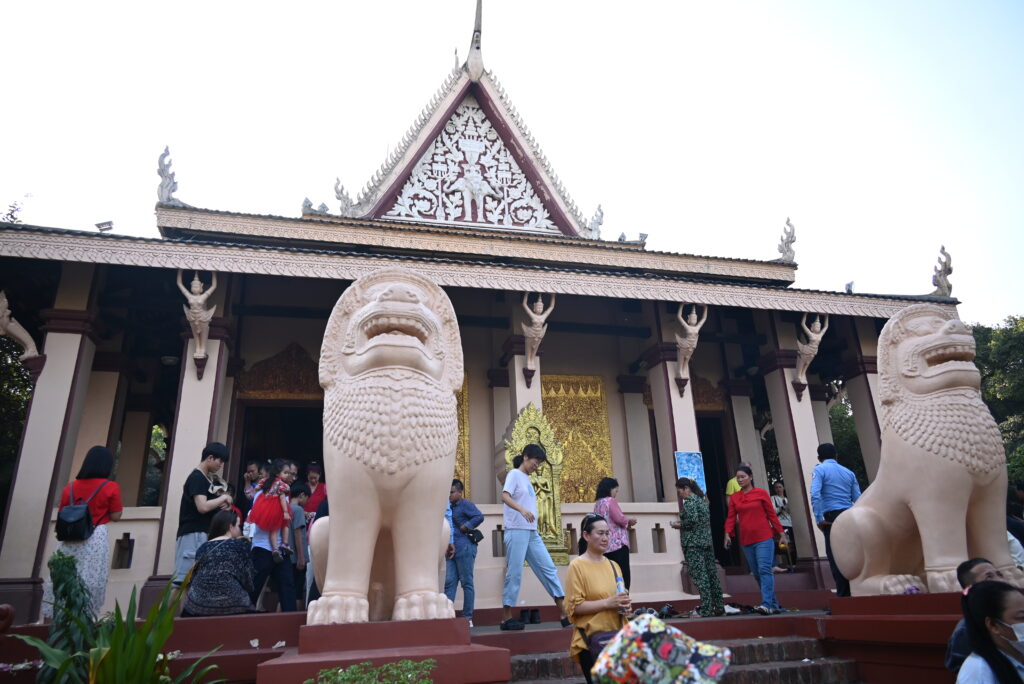
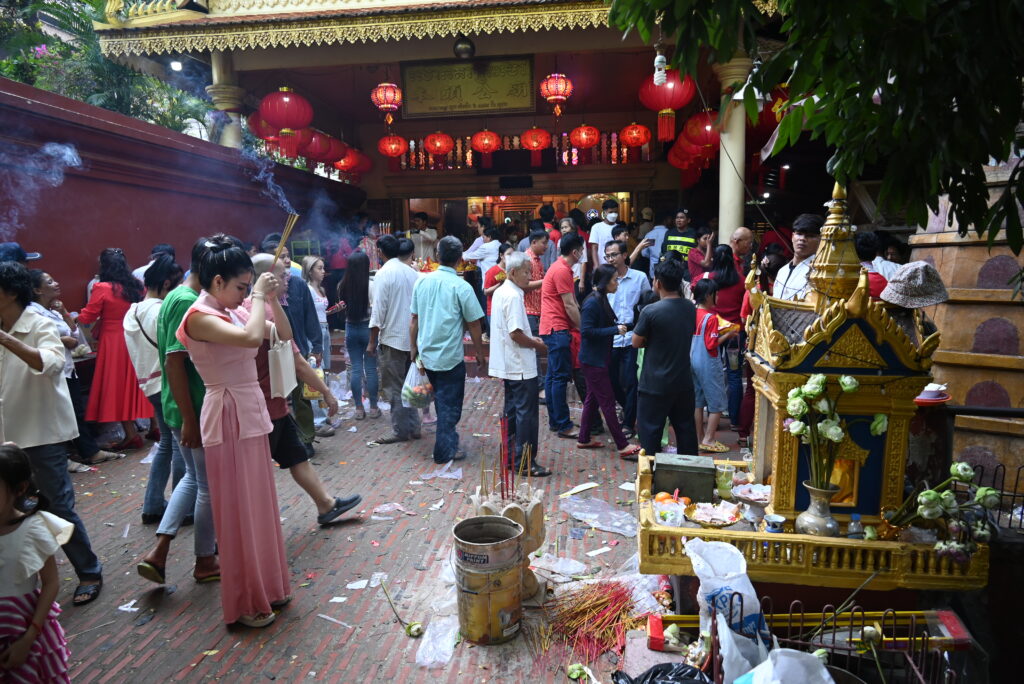


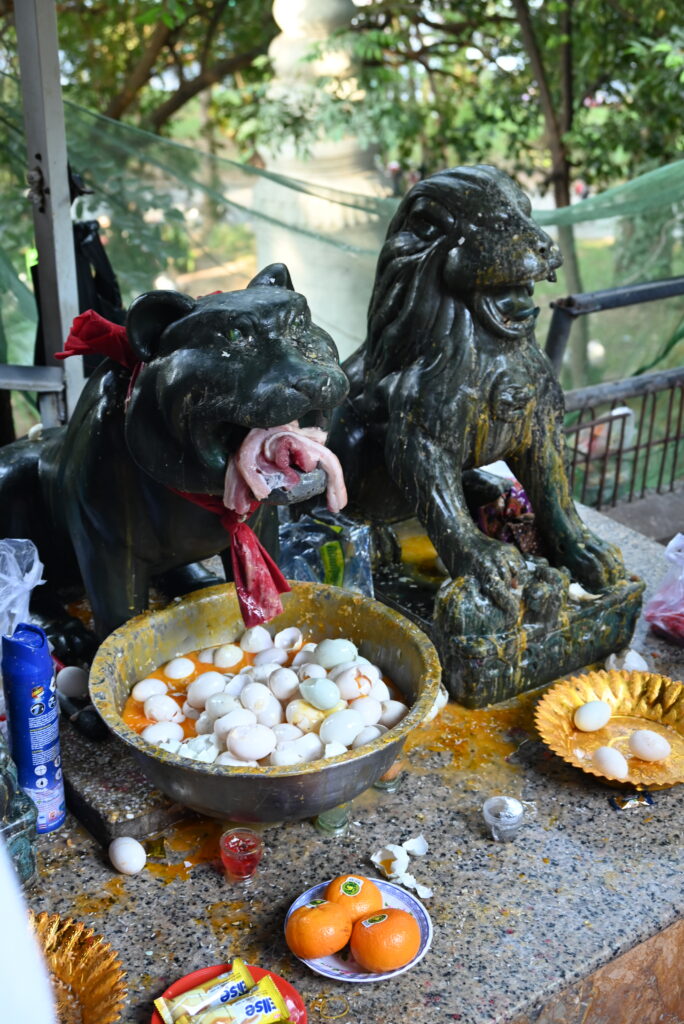
Day 7: We take advantage of the morning to visit the Independence Monument and the Buddhist monastery Wat Langka.


It’s already the end of our adventure in Cambodia. We depart from Phnom Penh in the afternoon for Taiwan, the next stop on our around-the-world journey.
Find all our other articles on Cambodia:


